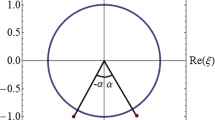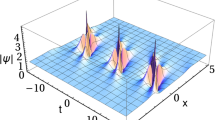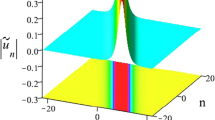Abstract
The Hirota equation is an extension of the nonlinear Schrödinger equation by incorporating third-order dispersion. Doubly periodic solutions for the Hirota equation are established in terms of theta and elliptic functions. Cubic dispersion preserves numerical robustness, as slightly disturbed exact solutions as initial states still evolve to the analytical configurations. In contrast with the nonlinear Schrödinger case, the wavenumber of the envelope must satisfy an algebraic equation related to the magnitude of the quadratic / cubic terms and the period of the wave patterns. The long wave limits of these doubly periodic patterns will yield the widely studied Kuznetsov-Ma and Akhmediev breathers. A cascading mechanism for the Hirota equation is studied, which will elucidate the first formation of breather modes. Higher harmonics exponentially small initially will grow at a larger rate than the fundamental mode. Eventually the high frequency modes reach roughly the same magnitude at one moment in time (or spatial location), signifying the first occurrence of breather. Breathers then decay and modulation instability emerges again for sufficiently small amplitude. The cycle is repeated and constitutes a manifestation of the Fermi-Pasta-Ulam-Tsingou recurrence. These analytical doubly periodic solutions will permit the prediction of the period of recurrence. These results can be applied in hydrodynamic and optical contexts where third or higher-order dispersion is present.









Similar content being viewed by others
Data availability
Data sharing is not applicable to this article as no datasets were generated or analyzed during the current study.
References
Craik, A.D.D.: Wave Interactions and Fluid Flows. Cambridge University Press, New York (1985)
Kivshar, Y.S., Agrawal, G.: Optical Solitons: From Fibers to Photonic Crystals. Academic Press, San Diego (2003)
Peregrine, D.H.: Water-Waves, Non-Linear Schrödinger-Equations and their solutions. J. Aust. Math. Soc. B 25, 16 (1983)
Onorato, M., Residori, S., Bortolozzo, U., Montina, A., Arecchi, F.T.: Rogue waves and their generating mechanisms in different physical contexts. Phys. Rep. 528, 47 (2013)
Chen, S., Baronio, F., Soto-Crespo, J.M., Grelu, P., Mihalache, D.: Versatile rogue waves in scalar, vector, and multidimensional nonlinear systems. J. Phys. A 50, 463001 (2017)
Conforti, M., Mussot, A., Kudlinski, A., Trillo, S., Akhmediev, N.: Doubly periodic solutions of the focusing nonlinear Schrödinger equation: Recurrence, period doubling, and amplification outside the conventional modulation-instability band. Phys. Rev. A 101, 023843 (2020)
Chin, S.A., Ashour, O.A., Belić, M.R.: Anatomy of the Akhmediev breather: Cascading instability, first formation time, and Fermi-Pasta-Ulam recurrence. Phys. Rev. E 92, 063202 (2015)
Campbell, D.K., Rosenau, P., Zaslavsky, M.: Introduction: The Fermi-Pasta-Ulam problem-The first fifty years. Chaos 15, 015101 (2005)
Kevrekidis, P.G.: Non-linear waves in lattices: Past, present, future. IMA J. Appl. Math. 76, 389 (2011)
Ford, J.: The Fermi-Pasta-Ulam problem: Paradox turns discovery. Phys. Rep. 213, 271 (1992)
Gallavotti, G.: The Fermi-Pasta-Ulam Problem: a status report. Springer, New York (2008)
Flach, S., Ivanchenko, M.V., Kanakov, O.I.: q-Breathers and the Fermi-Pasta-Ulam Problem. Phys. Rev. Lett. 95, 064102 (2005)
Yuen, H.C., Ferguson, W.E.: Relationship between Benjamin-Feir instability and recurrence in the nonlinear Schrödinger equation. Phys. Fluids 21, 1275 (1978)
Naveau, C., Szriftgiser, P., Kudlinski, A., Conforti, M., Trillo, S., Mussot, A.: Experimental characterization of recurrences and separatrix crossing in modulational instability. Opt. Lett. 22, 5426 (2019)
Van Simaeys, G., Emplit, P., Haelterman, M.: Experimental study of the reversible behavior of modulational instability in optical fibers. J. Opt. Soc. Am. B 19, 477 (2002)
Akhmediev, N.N., Eleonskii, V.M., Kulagin, N.E.: Exact first-order solutions of the nonlinear Schrödinger equation. Theor. Math. Phys. 72, 809–818 (1987)
Akhmediev, N., Ankiewicz, A.: 1st-order exact-solutions of the nonlinear Schrödinger-equation in the normal-dispersion regime. Phys. Rev. A 47, 3213 (1993)
Mihalache, D., Lederer, F., Baboiu, D.M.: 2-Parameter family of exact-solutions of the nonlinear Schrödinger-equation describing optical-soliton propagation. Phys. Rev. A 47, 3285 (1993)
Chow, K.W.: A class of exact, periodic-solutions of nonlinear envelope equations. J. Math. Phys. 36, 4125 (1995)
Chow, K.W.: A class of doubly periodic waves for nonlinear evolution equations. Wave Motion 35, 71 (2002)
Duval, P.: Elliptic Functions and Elliptic Curves. Cambridge University Press, Cambridge (1973)
Lawden, D.F.: Elliptic Functions and Applications. Springer, Berlin (1989)
Hirota, R.: Exact envelope-soliton solutions of a nonlinear wave-equation. J. Math. Phys. 14, 805 (1973)
Mihalache, D., Truta, N., Crasovan, L.-C.: Painlevé analysis and bright solitary waves of the higher-order nonlinear Schrödinger equation containing third-order dispersion and self-steepening term. Phys. Rev. E 56, 1064 (1997)
Ankiewicz, A., Soto-Crespo, J.M., Akhmediev, N.: Rogue waves and rational solutions of the Hirota equation. Phys. Rev. E 81, 046602 (2010)
Li, C., He, J., Porsezian, K.: Rogue waves of the Hirota and the Maxwell-Bloch equations. Phys. Rev. E 87, 012913 (2013)
Wang, L., Yan, Z., Guo, B.: Numerical analysis of the Hirota equation: Modulational instability, breathers, rogue waves, and interactions. Chaos 30, 013114 (2020)
Li, B., Zhao, J., Liu, W.: Analysis of interaction between two solitons based on computerized symbolic computation. Optik 206, 164210 (2020)
Dai, C.-Q., Wang, Y.-Y.: Coupled spatial periodic waves and solitons in the photovoltaic photorefractive crystals. Nonlinear Dyn. 102, 1733 (2020)
Wen, X., Feng, R., Lin, J., Liu, W., Chen, F., Yang, Q.: Distorted light bullet in a tapered graded-index waveguide with PT symmetric potentials. Optik 248, 168092 (2021)
Fang, Y., Wu, G.-Z., Wen, X.-K., Wang, Y.-Y., Dai, C.-Q.: Predicting certain vector optical solitons via the conservation-law deep-learning method. Opt. Laser Technol. 155, 108428 (2022)
Cao, Q.-H., Dai, C.-Q.: Symmetric and anti-symmetric solitons of the fractional second- and third-order nonlinear Schrödinger equation. Chin. Phys. Lett. 38, 090501 (2021)
Konno, K., Ito, H.: Nonlinear interactions between solitons in complex t-plane. I. J. Phys. Soc. Jpn. 56, 897 (1987)
Liu, T.Y., Chiu, T.L., Clarkson, P.A., Chow, K.W.: A connection between the maximum displacements of rogue waves and the dynamics of poles in the complex plane. Chaos 27, 091103 (2017)
Devine, N., Ankiewicz, A., Genty, G., Dudley, J.M., Akhmediev, A.: Recurrence phase shift in Fermi–Pasta–Ulam nonlinear dynamics. Phys. Lett. A 375, 4158 (2011)
Kimmoun, O., Hsu, H.C., Branger, H., Li, M.S., Chen, Y.Y., Kharif, C., Onorato, M., Kelleher, E.J.R., Kibler, B., Akhmediev, N., Chabchoub, A.: Modulation instability and phase-shifted Fermi-Pasta-Ulam recurrence. Sci. Rep. 6, 28516 (2016)
Soto-Crespo, J., Devine, N., Akhmediev, N.: Adiabatic transformation of continuous waves into trains of pulses. Phys. Rev. A 96, 023825 (2017)
Yin, H.M., Pan, Q., Chow, K.W.: Four-wave mixing and coherently coupled Schrödinger equations: Cascading processes and Fermi–Pasta–Ulam–Tsingou recurrence. Chaos 31, 083117 (2021)
Yin, H.M., Chow, K.W.: Breathers, cascading instabilities and Fermi–Pasta–Ulam–Tsingou recurrence of the derivative nonlinear Schrödinger equation: effects of ‘self-steepening’ nonlinearity. Physica D 428, 133033 (2021)
Grinevich, P.G., Santini, P.M.: The linear and nonlinear instability of the Akhmediev breather. Nonlinearity 34, 8331 (2021)
Haragus, M., Pelinovsky, D.E.: Linear instability of breathers for the focusing nonlinear Schrödinger equation. J. Nonlinear Sci. 32, 66 (2022)
Chen, J., Pelinovsky, D.E., White, R.E.: Rogue waves on the double-periodic background in the focusing nonlinear Schrödinger equation. Phys. Rev. E 100, 052219 (2019)
Eeltink, D., Armaroli, A., Luneau, C., Branger, H., Brunetti, M., Kasparian, J.: Separatrix crossing and symmetry breaking in NLSE-like systems due to forcing and damping. Nonlinear Dyn. 102, 2385 (2020)
Pelinovsky, D.E.: Instability of double-periodic waves in the nonlinear Schrödinger equation. Front. Phys. 9, 599146 (2021)
Chabchoub, A., Hoffmann, N., Tobisch, E., Waseda, T., Akhmediev, N.: Drifting breathers and Fermi-Pasta-Ulam paradox for water waves. Wave Motion 90, 168 (2019)
Ma, Y.L., Wazwaz, A.M., Li, B.Q.: New extended Kadomtsev-Petviashvili equation: multiple soliton solutions, breather, lump and interaction solutions. Nonlinear Dyn. 104, 1581 (2021)
Duran, H., Xu, H.T., Kevrekidis, P.G., Vainchtein, A.: Unstable dynamics of solitary traveling waves in a lattice with long-range interactions. Wave Motion 108, 102836 (2022)
Acknowledgements
Partial financial support has been provided by the Research Grants Council General Research Fund Contracts HKU17200718 and HKU17204722.
Funding
Research Grants Council General Research Fund, HKU17204722, K. W. Chow, HKU17200718, K. W. Chow.
Author information
Authors and Affiliations
Corresponding author
Ethics declarations
Conflict of interest
The authors declare that there is no conflict of interest.
Additional information
Publisher's Note
Springer Nature remains neutral with regard to jurisdictional claims in published maps and institutional affiliations.
Appendices
Appendix A
Theta functions are defined by Fourier series with exponentially decaying coefficients. In mathematical analysis, the Jacobi elliptic functions, sn, cn, dn can be expressed as ratio of theta functions. In classical mathematical analysis, theta functions are usually expressed as Fourier series with a real parameter q (τ purely imaginary):
K, K' are the complete elliptic integrals of the first kind with parameters k and (1 – k2)1/2. In terms of the patterns in the summations, there is an extra minus sign in front of the function θ1. In terms of basic mathematical properties, θ1 is odd while the other three are even. The zeros or roots of θ1, θ2, θ3, θ4, are located at square grids in the complex plane at Mπ + Nπτ, (M + 1/2)π + Nπτ, (M + 1/2)π + (N + 1/2)πτ, Mπ + (N + 1/2)πτ respectively, with M, N integers. We can readily show by direct calculations that θ1 and θ2, as well as θ3 and θ4, are related by a phase shift of π/2.
The Jacobi elliptic functions can be expressed as ratios of theta functions with ‘stretched’ arguments or variables as (for simplicity, the dependence on the parameter τ in Eqs. A1-A4 has been dropped in Eqs. A6, A7:
Theta functions possess many properties which make them ideal candidates for handling bilinear forms of evolution equations.
Sum and difference identities: Theta functions possess a huge varieties of identities:
By differentiating Eq. A8 with respect to y twice and setting y = 0,
i.e., the bilinear derivatives (‘D’ operator, defined below Eq. 4d) of theta functions can be expressed back in terms of the theta functions themselves through such ‘sum’ and ‘difference’ identities Eqs. A8, A9. Similar principles apply to the computations of
where m, n are integers.
Derivatives at specified values – By Taylor expansion of these sum and difference formulas and comparing powers, we relate the derivatives of theta functions to the functions themselves [20, 22], e.g.,
By differentiation using elementary calculus, we can simplify bilinear derivatives of products of exponential functions and the auxiliary variables, e.g.,
These formulas will be especially relevant in the present wave packet type calculations, as the carrier wave envelope is expressed as a complex exponential function multiplied by the auxiliary functions governing the actual packet structure (Eq. 4).
Appendix B
The parameters of analytical breather are as follows:
Based on Eq. B1, ζR and ζI can be determined by
Rights and permissions
Springer Nature or its licensor holds exclusive rights to this article under a publishing agreement with the author(s) or other rightsholder(s); author self-archiving of the accepted manuscript version of this article is solely governed by the terms of such publishing agreement and applicable law.
About this article
Cite this article
Yin, H.M., Pan, Q. & Chow, K.W. Doubly periodic solutions and breathers of the Hirota equation: recurrence, cascading mechanism and spectral analysis. Nonlinear Dyn 110, 3751–3768 (2022). https://doi.org/10.1007/s11071-022-07799-4
Received:
Accepted:
Published:
Issue Date:
DOI: https://doi.org/10.1007/s11071-022-07799-4




